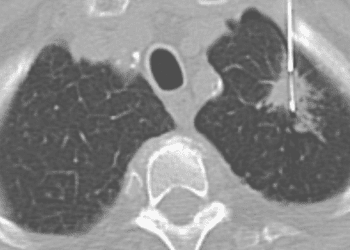Incidence of keratinocyte carcinoma disproportionately rising for young females over past two decades r
Incidence and mortality rates of keratinocyte carcinoma from 1998-2017: A population-based study of sex differences in Ontario, Canada
1. The incidence of and deaths related to keratinocyte carcinoma in Ontario is growing and rose disproportionately by age and sex between 1998 and 2017, with a greater incidence in young females compared to similarly-aged males.
2. Further epidemiological investigations are necessary to improve our understanding of relevant causal factors and support preventative public health measures.
Evidence Rating Level: 2 (Good)
Keratinocyte carcinoma, comprised of cutaneous squamous cell carcinoma (cSCC) and basal cell carcinoma (BCC), is the most common malignant disease in the Western world. Although keratinocyte carcinoma has a low mortality rate, it represents a significant health and economic burden in many countries. Nevertheless, it is not captured in most major cancer registries, limiting epidemiological studies. This retrospective observational study aimed to identify differences by sex in the incidence and mortality rates of keratinocyte carcinoma in Ontario, Canada between January 1, 1998, and December 31, 2017. It was found that, after decreasing from 1998 to 2003, the incidence rate of keratinocyte carcinoma increased by 30% to 369 per 100,000 males and 345 per 100,000 females in 2017 (average annual percentage change (AAPC) 1.9%, 95% CI 1.7 to 2.1 from 2003 to 2017). Younger females had a higher incidence of keratinocyte carcinoma and the most rapidly increasing rates compared with similarly-aged males, but the incidence was higher in males than females in older age groups and higher income quintiles. On average, annual mortality rates rose four times faster than the incidence in both sexes and were twice as high in males than in females. This study demonstrates that the population burden of keratinocyte carcinoma in Ontario is growing and that incidence and mortality rates rose disproportionately among certain age- and sex-specific groups. Further investigations exploring the epidemiology of keratinocyte carcinoma and differences by sex will better inform health service policy, public health initiatives, and patient education strategies, helping reduce disease burden and improve quality of life.
Click here to read the study in CMAJ
Relevant Reading: Keratinocyte carcinomas: Current concepts and future research priorities
In-Depth [population-based retrospective study]: This study used linked health administrative databases to identify adults (≥ 18 years) residing in Ontario between January 1, 1998, and December 31, 2017. Individuals who had a diagnosis of keratinocyte carcinoma before 1998 or those who were ineligible for health coverage under the Ontario Health Insurance Plan (OHIP) were excluded. Sociodemographic information, including age, sex, and socioeconomic status was extracted from the Registered Persons Database (RPDB), maintained by the Ontario Ministry of Health and Long-Term Care. The first recorded incidence of keratinocyte carcinoma per person was identified using a validated algorithm of OHIP claims (83%-85% sensitivity, 93%-99% specificity). Deaths from keratinocyte carcinoma were identified through the Ontario Registrar General Database (95% sensitivity, 86% specificity). Annual crude incidence and mortality rates with 95% confidence intervals were derived and direct standardization methods and the 1991 Canadian population were used to calculate age- and sex-standardized rates. Annual incidence rates over time, stratified by age group, sex, and income quintile, were plotted and analyzed using joinpoint regression. For each trend segment, the AAPC was calculated. From 1998 to 2017, a total of 646,480 adults were diagnosed with a first keratinocyte carcinoma and the median age at first diagnosis rose from 37.5 to 40.7 years. It was found that, from 1998 to 2003, the incidence rate of keratinocyte carcinoma declined annually. This decline was followed by a steady rise to a rate of 356.7 per 100,000 in 2017 (AAPC 1.9%, 95% CI 1.7% to 2.1%), representing an increase of 30% over a 14-year period. In adults under 55 years of age, the incidence rate was higher in females. In adults 55 years of age or older, the incidence rate was higher in males. Stratified by age, the rates of increase in annual incidence among females aged 45–64 years significantly outpaced that in males of the same age group (p ≤ 0.01), though AAPCs were similar between sexes for ages 18–44 years and 65 years and older. Furthermore, the incidence rate was higher in males than females in higher income quintiles. Between 1998 and 2017, the mortality rate of keratinocyte carcinoma rose 4.8-fold overall and was found to be 1.8 times higher in males than females, on average (AAPC 8.9%, 95% CI 6.4 to 11.4 in males; 8.0%, 95% CI 5.3–10.8 in females).
Image: PD
©2021 2 Minute Medicine, Inc. All rights reserved. No works may be reproduced without expressed written consent from 2 Minute Medicine, Inc. Inquire about licensing here. No article should be construed as medical advice and is not intended as such by the authors or by 2 Minute Medicine, Inc.




![2 Minute Medicine: Pharma Roundup: Price Hikes, Breakthrough Approvals, Legal Showdowns, Biotech Expansion, and Europe’s Pricing Debate [May 12nd, 2025]](https://www.2minutemedicine.com/wp-content/uploads/2025/05/ChatGPT-Image-May-12-2025-at-10_22_23-AM-350x250.png)


